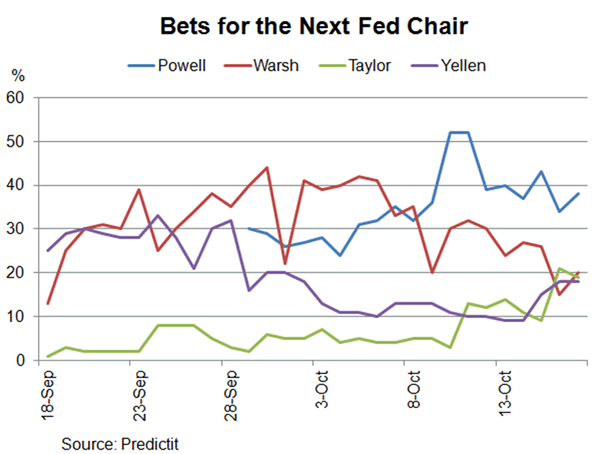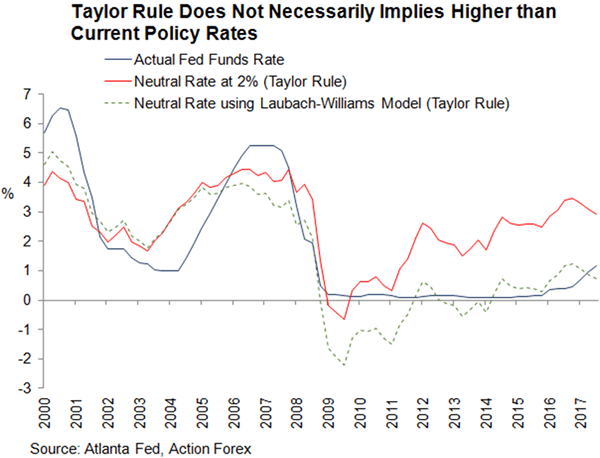Lacking other exciting news, the market was thrilled by the media report that US President Donald Trump was impressed by Stanford University Economic John Taylor at the Fed Chair candidate interview. Bets for Taylor to be the next Fed chair increased, making him one of the top three candidates alongside Jerome Powell and Kevin Warsh. Market reaction to the rise of Taylor was USD strength and an upward shift in the UST yield curve, hinging on hopes that this creator of the Taylor rule would accelerate the pace of rate hike if he has become the Fed’ chief. We believe such expectation is a bit too far-fetched.
First, the Fed’s monetary policy decision is made by a committee of 12 voting members. As such, it would be difficult for a more hawkish or dovish Chair to alter the final decision. Second, although the Taylor rule implies a much higher policy rate than then current one, the elements comprising the formula is not unchangeable. Indeed, Taylor last week suggested that "one can easily adjust the equilibrium interest rate in the rule". It is expected that his stance would be more aligned with the mainstream if he is appointed. Third, a hawkish Fed chair would be in conflict with Trump’s economic policy which aims at boosting growth with deregulation and tax reform. Trump in his election campaign had reiterated a number of times his preference for a weak US dollar. Assuming the US economic developments continue as expected by the Fed, its monetary stance would be more or less unchanged, i.e. rate hike to remain gradual and data-dependent while balance sheet reduction would carry out as schedule, with whoever being the next chair.

Fed Chair Appointment
It is widely believed that Trump would announce his decision on the next Fed chair before he leaves for Asia on November 3. The market has identified five key candidates for the role, namely, Jerome Powell, Kevin Warsh, John Taylor, Gary Cohn and Janet Yellen. While the dovish-centre Powell remains the most likely candidate, bets for Warsh and Taylor have been rising of late. Both Warsh and Taylor are considered as in the hawkish camp. For the former, he criticized at the Hoover Institution Monetary Policy Conference in May about the Fed’s balance sheet reduction strategy, noting that the "preferred sequencing of rate increases and balance sheet reductions differ markedly from what was agreed when we conceived QE in the ‘war room’ amid the crisis". Back in 2010, Warsh criticized the then-Fed chair Ben Bernanke’s QE extension.
Talk is cheap. During his capacity as a FOMC governor from 2006 to 2011, Warsh voted largely in line with the majority in the majority. He had not dissented on any vote cut and QE decision during the period of GFC. He also voted for the second round of QE, despite his reservation.
Taylor Rule, Taylor Rules?
Taylor is believed to be the "most hawkish" candidate amongst the five. This also explains why the greenback and Treasury yields rose after reports suggesting that Trump has good impression on him.
Taylor’s hawkish image is more driven by his eponymous monetary policy rule (Taylor Rule), which implies that the Fed funds rate should be much higher than the current rate. The Atlanta Fed website (https://www.frbatlanta.org/cqer/research/taylor-rule.aspx) has a simulated Taylor rule model for one to plug in different values to get various estimates of Fed fund rates. If the neutral rate is set at the traditional 2%, the Fed funds rate, using Taylor rule, would be 2.94%, compared 1.25% currently. However, if we set the neutral rate at -0.2%, one derived from the model developed by San Francisco Fed president John Williams and Thomas Laubach, the Fed funds rate would be around 0.74%. This illustrates that how one interprets the neutral rate, another elements in the Taylor rule, affect the outcome.

For John Taylor himself, his monetary stance may not be as hawkish as one has expected. In his speech titled Rules Versus Discretion: Assessing the Debate Over the Conduct of Monetary Policy at the Boston Fed conference last Friday, Taylor noted that "one can easily adjust the equilibrium interest rate in the rule". He added that the most important suggested change in policy rules in recent years is probably to "adjust the intercept to accommodate the lower estimate of the equilibrium real interest rate (R*)". He appears content with the situation that the FOMC members have recently adjusted the average estimate of the neutral by "at least one percentage point lower" than the original 2%.
Fed’s Monetary Decision Marking
Unlike the RBNZ in which the government has unique power over the interest rate decision, the Fed’s monetary decision is determined by the FOMC, a Committee consisting of 12 voting members: 7 members of the Board of Governors , the New York Fed president, and 4 of the remaining 11 Fed presidents, who serve one-year terms on a rotating basis. For the members in the Board of Governors, a full term is fourteen years with one term beginning every two years. A full term for the New York Fed president is five years. As such, the Committee turns over slowing. This avoids drastic changes in the monetary stance. There are also nonvoting fed presidents who attend the FOMC meetings, participate in the discussions, and contribute to the Committee’s assessment of the economy and policy options. It would be quite impossible for the chair to override the monetary decision.
An important feature of Trumponomics is to stimulate US economy through deregulations and tax reform. He has also proposed improving the country’s competitiveness on trade by a weak US dollar. It would be conflicting if the Fed chair he chooses turn out to be hawkish which would potentially send the currency higher.
We do not expect the next Fed chair to very much derail from the current monetary stance which seeks to increase the policy rate gradually and as the economic data justify. The balance sheet normalization process would also be largely in line with schedule.













